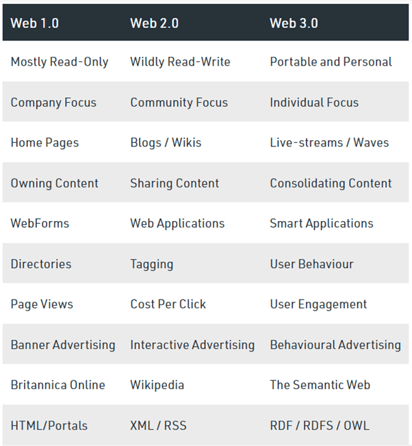Web3 could very well be the future of the internet. It involves a space where people operate on decentralised, almost anonymous platforms. This means moving away from the big, guiding hands of tech giants like Google, Facebook, and Twitter.

Web 3.0 was originally called the Semantic Web by World Wide Web inventor Tim Berners-Lee, and was conceived as a more autonomous, intelligent, and open internet.
This internet would involve AI and ML which would process content like a "global brain", with all data being connected in a way that is contextual and conceptual. But this didn't pan out. The tech just wasn't.
What has grown from Web 2.0 is more similar to Berners-Lee's original web, which he described as a place where “no permission is needed from a central authority to post anything … there is no central controlling node, and so no single point of failure … and no “kill switch”.
So, the decentralised technologies that have exploded in the last few years - De-Fi, Blockchain, NFTs, AR Cloud, Distributed ledgers, AI and ML, and The Metaverse - will mean a move toward data decentralisation and a transparent, secure internet. Something that seems almost alien compared to Web 2.0's centralisation, data surveillance, and all-too-accurate prevalent advertising.
This all leads to a Web 3.0 where users interact in a decentralised way, but with security. From money to information, all exchanges are conducted without the need for tech companies, banks, or any other middlemen.
So if Web 2.0 makes the user the product, Web 3.0 makes the user the content owner.
A few elements that define Web 3.0 may include:
- Semantic web, where web tech is improved to create, share, and connect content through search and analysis, based on comprehension, not key words.
- AI and ML
- Connectivity of multiple applications and devices, through the Internet of Things
- 3-D graphics
- Interactivity without the need to go through a trusted intermediary
- Participation without the need for authorisation from a governing body
Thanks to Geeksforgeeks.org, we can see all of this in a handy lil table. Very Web 1.0 of them:

The History of Web3
- Based on Blockchain Type, Global Web 3.0 Blockchain Market is segmented into Public, Private, Consortium, and Hybrid.
- In 2014, Gavin Wood, founder of Polkadot and co-founder of Ethereum, used the term “Web3” to describe a decentralized online ecosystem based on blockchain.
- 438 Web 3.0 companies have raised over $4.5 billion in funding so far.
- Polkadot is the top-ranked Web3 token by market capitalisation ($17.48 billion).
- The term Web3 gets searched 195,000 times per month on Google.
- In the second quarter of 2022, 48 major attacks were monitored in the Web3 space, with total losses of approximately $718.34 million, down approximately 40 per cent from $1.2 billion in the first quarter and approximately 2.42 times the losses in Q1 2021 ($296.56 million).
Web 3.0 Market Growth
- The Global Web 3.0 Blockchain Market revenue is expected to reach a value of USD 23.3 Billion in the year 2028.
- $678bn is forecasted to be the total market valuation of the metaverse by 2030, per Grand View Research. According to the report, that market value was just shy of $39bn in 2021, giving it a predicted compounded annual growth rate over a 10-year period of around 39%
- By 2026, about 2 billion people worldwide “will spend at least one hour a day in the metaverse to work, shop, attend school, socialize or consume entertainment,” per McCann Worldgroup. By that same year, the total value of the virtual goods market in the metaverse could be as high as $200bn
- Dubai stated in March 2022 that it had enacted a new cryptocurrency law to oversee the activities of digital assets and cryptocurrencies as it strives to become a Web 3.0 powerhouse. The UAE intends to establish a Dubai Virtual Assets Regulatory Authority under the new law, which will be in charge of regulating blockchain-based virtual assets.
Public Response to Web3
- 51% of gen Z and 48% of millennials envision doing some of their work in the metaverse in the next two years, according to Microsoft’s Work Trend Index 2022
- 38% of respondents said they would “try extreme sports like skydiving, bungee jumping, or paragliding” in the metaverse according to a recent Statista survey called ‘What things would you do in the metaverse but never in real life?’ Unsettlingly, 18% of respondents said they would “conduct unethical experiments on virtual humans”
- 87% of Americans between the ages of 13-56 would be interested in engaging with a virtual experience in the metaverse “that is built around a celebrity they love,” according to new research from UTA and Vox Media
- 46% of all people across age groups say that the ability to visualise a virtual product in an IRL context – “such as seeing a digital painting in their home using augmented reality (AR) glasses” – is the primary factor that would motivate them to make a purchase in the metaverse, per a Productsup survey
- 15% of gen Zs’ “fun budget” is spent in the metaverse, per a report from Razorfish and Vice Media Group. In five years that number is projected to climb to 20%
- Nearly 77% believe that the metaverse “can cause serious harm to modern society,” per a recent survey from customer service platform Tidio. The survey, which received feedback from 1,000 participants, identified three major causes of anxiety related to the metaverse and its potentially negative social impacts: “addiction to a simulated reality” was the number one concern, followed by “privacy issues” and “mental health issues,” which were tied for second
- Only 9% of people aged 16-44 own a NFT, and less than half (44%) have purchased or invested in crypto, per a new survey from agency SCS. On the other hand, among the survey’s 600 respondents, 64% were “aware” of the metaverse, and 65% of that subgroup say they are “interested in exploring it further for everything from traveling to new places and playing games to making money and shopping”
- 54% of respondents believe it is very important that more brands accept cryptocurrency as a form of payment, despite the recent crash in the crypto market, according to a recent survey from Klaviyo
- 81% of consumers who have heard about Web 3.0 think that it will improve their happiness and wellbeing.
- The most common worry about Web 3.0 is that it will make cybercrime more common.
- 43% of users want Web 3.0 to be regulated even more stringently than the Internet currently is.
Asia-Pacific Embracing Of Web3
- One region that is seeing the most action is Asia-Pacific. Thanks to a boom in DeFi, cryptocurrency activities have grown over 700% in the region”
- All of this has boosted conversations around the future of digital technologies, more specifically, the future of the internet as Web3.
- China has the highest search popularity of the term web3.
Web3 Developers and Job Roles
- 18,000+ developers are actively working on open-source crypto and Web3 projects.
- Indian VC firms have pledged $150+ million over the next 3 years to support Indian Web 3.0 startups
- The average Web3 developer salary is in the range of $70,000 to well over $350,000 per year.
- According to a recent report, there were roughly 18,000 active Web3 developers in December 2021. 60% of them just started in 2021 and 20% of the new joiners chose Ethereum as their ecosystem.
- Companies that are located in the United States, and California in particular, seem to pay a higher Web3 developer salary than those in the rest of the world.
Web 3 and Hacking
- Nearly 77% believe that the metaverse “can cause serious harm to modern society,” per a recent survey from customer service platform Tidio. The survey, which received feedback from 1,000 participants, identified three major causes of anxiety related to the metaverse and its potentially negative social impacts: “addiction to a simulated reality” was the number one concern, followed by “privacy issues” and “mental health issues,” which were tied for second
- According to a recent study by Web 3 security firm Beosin, over $718 million were lost to Web 3-related schemes during the second quarter of 2022.
- The report says 48 major “attacks” were responsible for the losses incurred. Each accounted for over $100 million in losses, with 28 incurring losses of $1 million to $10 million.
- According to the data, the most common attack method was to exploit vulnerabilities in the smart contract code, resulting in the loss of $138 million. These comprised 45.8% of attacks, compared to 50% in Q1.
- By project type, DeFi continues to have the greatest rekt frequency; approximately 79.2% of attacks occur in the DeFi domain.
- Approximately $418.89 million in stolen funds were transferred to Tornado.cash by hackers, representing 58.3% of the total amount stolen during the quarter.
- Forty-three major rug pull incidents on the chain were monitored this quarter, with total losses of approximately $34,266,402. From incomplete statistics, Discord servers were hacked more than 151 times. Rug pull and phishing security incidents were frequent in May and June.
- The report also mentioned that Ethereum saw a loss of $381.35 million last quarter due to the hacking spree.